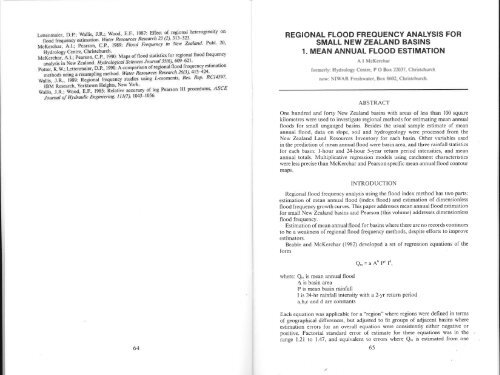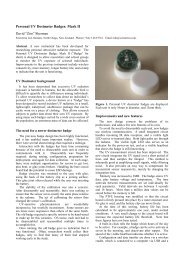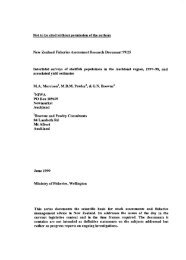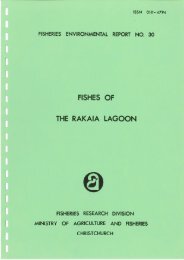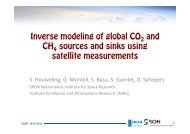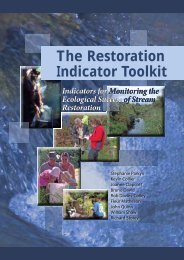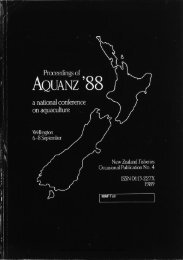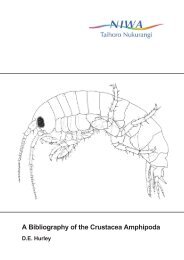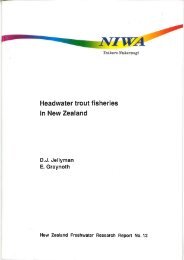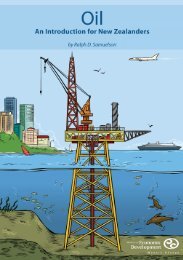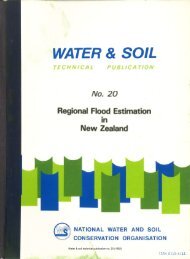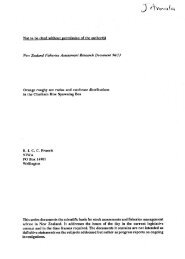regional flood frequency analysis for small new zealand basins 1.
regional flood frequency analysis for small new zealand basins 1.
regional flood frequency analysis for small new zealand basins 1.
- No tags were found...
You also want an ePaper? Increase the reach of your titles
YUMPU automatically turns print PDFs into web optimized ePapers that Google loves.
REGIONAL FLOOD FREQUENCY ANALYSIS FORSMALL NEW ZEALAND BASINS<strong>1.</strong> MEAN ANNUAL FLOOD ESTIMATIONA I McKerchar<strong>for</strong>merly: Hydrology Centre, P OBox22037, Christchurchnow: NIWAR Freshwater, Box 8602, Christchurch.ABSTRACTOne hundred and <strong>for</strong>ty New Zealand <strong>basins</strong> with areas of less than 100 squarekilometres were used to investigate <strong>regional</strong> methods <strong>for</strong> estimating mean annual<strong>flood</strong>s <strong>for</strong> <strong>small</strong> ungauged <strong>basins</strong>. Besides the usual sample estimate of meanannual <strong>flood</strong>, data on slope, soil and hydrogeology were processed from theNew Zealand Land Resources Inventory <strong>for</strong> each basin. Other variables usedin the prediction of mean annual <strong>flood</strong> were basin area, and three rainfall statistics<strong>for</strong> each basin: l-hour and 24-hour 5-year return period intensities, and meanannual totals. Multiplicative regression models using catchment characteristicswere less precise than McKerchar and Pearson specific mean annual <strong>flood</strong> contourmaps.INTRODUCTIONRegional <strong>flood</strong> <strong>frequency</strong> <strong>analysis</strong> using the <strong>flood</strong> index method has two parts:estimation of mean annual <strong>flood</strong> (index <strong>flood</strong>) and estimation of dimensionless<strong>flood</strong> <strong>frequency</strong> growth curves. This paper addresses mean annual <strong>flood</strong> estimation<strong>for</strong> <strong>small</strong> New Zealand <strong>basins</strong> and Pearson (this volume) addresses dimensionless<strong>flood</strong> <strong>frequency</strong>.Estimation of mean annual <strong>flood</strong> <strong>for</strong> <strong>basins</strong> where there are no records continuesto be a weakness of <strong>regional</strong> <strong>flood</strong> <strong>frequency</strong> methods, despite ef<strong>for</strong>ts to improveestrmators-Beable and McKerchar (1982) developed a set of regression equations of the<strong>for</strong>mq-=aAoP"Id,where: Q- is mean annual <strong>flood</strong>A is basin areaP is mean basin rainfallI is 24-hr rainfall intensity wilh a 2-yr return perioda,b,c and d are constants64Each equation was applicable <strong>for</strong> a "region" where regions were defined in termsof geographical differences, but adjusted to fit groups of adjacent <strong>basins</strong> whereestimation errors <strong>for</strong> an overall equation were consistently either negative orpositive. Factorial standard error of estimate <strong>for</strong> these equations was in therange l.2l to <strong>1.</strong>47, and equivalent to errors where Q* is estimated from one65
to five years of record. These error statistics are likely to be underestimatesbecause they do not include uncertainty about the placement of regions-Mosley (1979) used morphologic reach and cross-section variables to estimateQ. <strong>for</strong> 73 South Island rivers. The factorial standard error <strong>for</strong> the best equationusing all 73 rivers was <strong>1.</strong>7<strong>1.</strong> This reduced to <strong>1.</strong>52 <strong>for</strong> 63 non-braided rivers.McKerchar and Pearson (1989) drew contour maps to use to estimate Q-/Au'8 (division by A0 8 removes the effect of basin area) <strong>for</strong> any basin. The mapswere developed using data from 343 <strong>basins</strong>. Proportional errors of estimatesfrom the maps were defined by:E = t00 (Q., _ Q..)/Q*,.where: Q.. is the "<strong>regional</strong>" mean annual <strong>flood</strong> estimate inferred from the map,and Q,,, is the "at-site" estimate of mean annual <strong>flood</strong>, i.e. the estimate of Q-from the <strong>flood</strong> series.E values showed a mean of 8.6%a, (i.e. the bias) and a root mean square errorof -1557aE values ranged from 697o to 578%. Nineteen sites, (i.e. 570 of sites) withE exceeding 7070 were discarded as outliers. Statistics <strong>for</strong> the remaintng 95c/oof sites were bias = -0.970 and root mean square error = t227a, so that thestandard error of estimate of Q. from the maps was 1227a. This was animprovement over the Beable and McKerchar equations, which also discardedabottt 5Vo of the catchments as outliers.Results were more variable <strong>for</strong> <strong>small</strong> <strong>basins</strong> than <strong>for</strong> larger <strong>basins</strong>. For all<strong>basins</strong> with areas less than l0 km2, McKerchar and Pearson obtained thefollowing:All <strong>basins</strong> (10 km2Outlìers excludedNo- Basins4943Bias (Va)22-0.7Root MeanSquare ErrorOutline of problemThe error statistics <strong>for</strong>'all <strong>basins</strong> (10 km2" are unacceptably large <strong>for</strong> design<strong>flood</strong> estimation. With "outliers excluded" the error statistics are acceptable,but the question of what is an outlier is not resolved, and this raises doubtabout the reliability of the method. Also, the outliers are disproportionatelyrepresented among the <strong>basins</strong> with area (10 km2- Are the six records all inerror, or are they conveying in<strong>for</strong>mation about hydrological conditions notadequately represented by the contour maps? For example, the scale of themaps and the level of smoothing in their contours may mask much real variationbetween <strong>small</strong> <strong>basins</strong>. Can additional in<strong>for</strong>mation be employed to improve<strong>regional</strong> estimates of <strong>flood</strong> statistics?669234.(¿\,4:t")["r*\ y'-t.ii ,.80201rt0 100 200 kmFIG. I Location of the 140 <strong>small</strong> (A < 100 km2) New Zealand <strong>basins</strong> used in this study.Site numbers from Walter (1990).The additional in<strong>for</strong>mation available in the NZ Land Resource Inventory(Ministry of Works and Development, 1979) includes broad classes of rock type,overland slope, vegetation and soils. This in<strong>for</strong>mation can be extracted froma database <strong>for</strong> any basin boundary, and this study sought to use it to improveestimates of mean annual <strong>flood</strong> <strong>for</strong> <strong>small</strong> <strong>basins</strong>.\I/. z.t tz's.ro"r" //.Asazl73so1 474360. /,470167
METHODData compílationTo assemble sufficient data <strong>for</strong> comprehensive <strong>analysis</strong> the area threshold wasraised from l0 to 100 km2. Data <strong>for</strong> 140 <strong>basins</strong> with areas less than 100 km2,and at least six years offlow records were assembled (Fig. l).The data assembled <strong>for</strong> each basin were:Mean annual <strong>flood</strong> (Q.): This quantity is the arithmetic mean of peak-discharges <strong>for</strong> each of at least six years of record. These data were extractedfrom streamflow archives up to and including 1989 (Tideda: Rodgers andThompson, l99l). Length of record (N years) is given beside the mean. Wherepossible the stage series are checked <strong>for</strong> consistency against records <strong>for</strong> adjacent<strong>basins</strong>. Reliability ofthe rating curves, which are calibration curves to trans<strong>for</strong>mstage to discharge, is problematical. Most of these <strong>small</strong> <strong>basins</strong> are fittedwith weirs or bed-control structures calibrated using laboratory data. Wherefreld calibration is limited to low flows, it is difhcult to determine whetherthe adopted ratings are correct, especially at <strong>flood</strong> extremes beyond the rangeof conventional laboratory calibrations. This implies that annual maximum<strong>flood</strong> peak estimates <strong>for</strong> these <strong>basins</strong> are less reliable than those <strong>for</strong> <strong>basins</strong>with higher-stage current-meter gaugings (Potter and Walker, 1985).Area (A): Basin area is defined on the NZMS 260 (l:50000) or NZMS- I (l:63360) map series, and listed in Walter (1990).Rainfall intensity (Ir and Iz+): Five-year return period rainfall depths <strong>for</strong>-l-hr and 24-hr duration storms were estimated from maps in Tomlinson (1980).These depths are areal means <strong>for</strong> each basin, but are not adjusted by arealreduction factors. In the Tomlinson maps Ir is estimated from a sparse networkof recording raingauges, whereas Izq is estimated using a much morecomprehensive set of daily-read manual raingauges, and is more reliable.Mean annual raìnfall (P): An areal mean annual rainfall was estimatedfrom the map of 195l-1980 normals in NZ Met. Serv. (1985).Hydrogeology (H): Derivation of a basin estimate of "hydrogeology" is-explained in Hutchinson (1990). In summary, each combination of rock typesin the Land Resource Inventory is assigned a scalar number ranging fromI <strong>for</strong> low to 8 <strong>for</strong> high bedrock infiltration capacity and transmissibility. Lowvalues are assigned to strongly indurated sedimentary rocks, and igneous andmetamorphic rocks. Medium values are assigned to pyroclastics, loess, crushedargillites, "soft" volcanics, and weakly indurated sediments. High values areassigned to ashes, brecci4 scoria, lapilli, alluvium, colluvium, glacial till, peatand wind-blown sand. A basin mean is calculated as a sum weighted by theproportion of basin area occupied by each class.Slope (S): The Land Resource Inventory classifies parcels of land into-seven slope classes 4...G defined as:A -0-3o, flat to gently undulatingB 4-7", undulating-C 8-15', rollingD -16-20", strongly rollingE 21 25o, moderately steepF-26-35o, steep-G- >35', very steep 68Areally weighted mean slope is calculated as:S = <strong>1.</strong>5 S"+ 5.5 Su+ ll.5 S" + 18 S¿ + 23 S"+30.5 S¡+ 38 Sewhere Su, S¡, ... Se are the decimal proportions of the catchment area occupiedby ground in the slope classes A, B, ... G respectively.Soil Properties: A soil description applies to each Land Resource Inventory-parcel. Three soil properties considered to affect rapid runoff were (MJ Duncan,pers. comm-, l99l):Soit drainage (D): a scalar ranging from I to 7, I representing very poor- esenting excessive drainage.MacroporositY determined in theparticular soil horizon. A dePthofmacroPorositY <strong>for</strong> the wholehorizon. Typically macroporosities are in the range 0 to 30%0.Minimum porosity (MP): Minimum porosity <strong>for</strong> each soil class was-estimated.Area-weighted estimates of these three quantities were calculated'All the data are assembled in the Appendix, and summary statistics are givenin Table <strong>1.</strong>TABLE l-summary of basin characteristic statistics of 140 <strong>basins</strong> listed inAppendix.CHARACTERISTICMINIMUMMAXIMUMMEANSTANDARD DEVCHARACTERISTICMINIMUMMAXLMUMMEANSTANDARD DEVQ.(m3/s)0.054389.249.369. rH<strong>1.</strong>08.04.42.5A(ha)<strong>1.</strong>420996330612891S(deg)<strong>1.</strong>535.4t9.78.0I:(mm)l312834l3Dr.07.04.3t.lAnalysis proposedMultiple regression is proposed <strong>for</strong> the <strong>analysis</strong> using the <strong>for</strong>mQ*=aXrbXz"...lro P(mm) (mm)45 550660 I 1700t54 196872 l30lDWP MP(70) (Va)t.2 0.029.3 26.013.9 8.76.1 5.0where: X:, Xz -.. are basin characteristics (e.g. Area A, mean annual rainfallP, hydrogeology H, etc), and a, b, c ... are coefficients determined by multiplicativeregressron.69
Analysis with subsets of the data is proposed, \,ith the subsets defined as:a) arbitrary splits of the data, e.g. into four sets with high rainfalt P and highminimum porosity MP, high P and low MP, low P and high MP, low P andlow MP; with the high/low splits <strong>for</strong> P and MP taken as the median value.b) Clusters of data using the algorithm K-means of SYSTAT (Wilkinson, I986),which splits data into groups such that between-group variation is maximisedand within-group variation minimised. Variation is measured as the Euclideandistance between data <strong>for</strong> a basin and the group mean. These methods avoidsplits based on loose geographic regions.RESULTSData statisticsThe compiled data statistics (Table l) reflect the very large range of hydrologicalconditions encountered across the country.For example, mean annual rainfalls range from 550 to 11700 mm/yr, meanbasin slopes from <strong>1.</strong>5 to 35 degrees, depth-weighted macroporosity ranges froml.2Vo to 29.3V0, and minimum porosity ranges from ÙVo to 26.6%.Hydrogeology and drainage, both measures ofinfiltration, are near their upperbounds <strong>for</strong> volcanic ash-covered Central North Island <strong>basins</strong> where Q./Au'oare low. For example <strong>for</strong> Mangakara (site number 1043434), hydrogeology H= 7.5, soil drainage D = 6.2, and the porosity measures (DWP = 26.lEo, MP= 16.870) are amongst the highest <strong>for</strong> all the 140 <strong>basins</strong>, and Q./A'o is 0.36(Q* in m3/s, A in km2) . In contrast, <strong>for</strong> two <strong>basins</strong> in Northland (Pukewaenga,46662 and. Pukeiti, 46663) intensity lz+= 155 mm is almost identical to Mangakara(Iz+ = 150 mm), but Q./Ao' = 5.0 and 5.4 respectively, and <strong>for</strong> both <strong>basins</strong>hydrogeology H = 4.0, soil drainage D = <strong>1.</strong>0, depth-weighted macroporosìtyDWP = 2.1/s and, minimum porosity MP = o.lTa. The low values of the latterthree parameters reflect the poor drainage and low porosities of the heavy clayeysoils in these <strong>basins</strong>.Another basin with unusually low values <strong>for</strong> Q-/40'8 is Maryburn (71122)in the central South Island. Here Q./N8 = 0.17, and the intensity estimateis Iz¿ = 80 mm. Hydrogeology H = 8.0, soil drainage D = 5.0, depth weightedmacroporosity DWP = 20.Wa and minimum porosity MP = 15.5Va, are all greaterthan the respective means across all <strong>basins</strong> (Table I ). This basin has been discardedas an outlier in previous studies.For many <strong>basins</strong> at the extremes of the dataset, there is an inverse correlationbetween the <strong>flood</strong> parameter Q-/Ao't, and the Land Resource Inventoryderived quantities, soil drainage D, depth-weighted macroporosity DWP and -minimum porosity MP. This study seeks to verify this correlation across a largesample of data, and to use it to provide better estimates of Q. <strong>for</strong> ungauged<strong>basins</strong>.CorrelationsFor logarithms (base l0) of data, correlation coefficients (Table 2) are generallypositive. Correlation of log (Q.) with area is notable, but otherwise its correlationsare weak. Correlations between the three rainfall parameters and between thethree soil parameters are also notable. These suggest that just one rainfall andone soil parameter may be sufficient as independent variables.70TABLE 2-Correlation matrix <strong>for</strong> logarithms of basin characteristics.Q,a. l.0ooA 0.879P 0.500\ 0.3720Á41lzqH -0.131s 0.082D 0.064DWP 0.116MP 0.145<strong>1.</strong>0000.262 <strong>1.</strong>0000.062 0.7540.160 0.804-0.006 0.0600.1l0 0.0540.219 0.1510.287 0.2040.298 0.155lrIzq H S D DWPMPl.0000.883 <strong>1.</strong>0000.076 0.094 <strong>1.</strong>0004.052 -0.032 -0.431 <strong>1.</strong>000-0.011 0.057 -0.017 0.248 <strong>1.</strong>0000-025 0.103 0.064 0.209 0.876 <strong>1.</strong>0000.032 0.109 -0.001 0.245 0.895 0.884 <strong>1.</strong>000Regression <strong>analysis</strong>Table 3 gives a selection of regression results using all the data. The resultsgiven are the best result, in terms of minimum standard error, <strong>for</strong> l, 2, 3, and4 variables. The standard errors and factorial standard errors, ofsimilar magnitudeto those reported <strong>for</strong> country-wide equations in Beable and McKerchar (1982),are too large <strong>for</strong> the results to be used <strong>for</strong> design <strong>flood</strong> estimation.TABLE 3-Multiplication regression results <strong>for</strong> prediction of Q. using all 140<strong>basins</strong>. "t" is Student's statistic; "Rz" is coefficient of determination;and "s.e." is standard error-No.VariableVariables NameI2AAlzoAIztHAII¿HDWPCoef.s.e.tRR2b,c,d ofcoef0.856 0.0400.808 0.031r 559 0.1600.805 0.028l.ó35 0.r464.422 0.0170.848 0.026<strong>1.</strong>679 0.t3t{.397 0.069{.606 0.102217 0.879 0.713 0.4n26.2 0.930 0.866 0.3t79.7281 0.9M 0.890 0.288<strong>1.</strong>2-5.5325129-58-60s.e . Factorial Const Multþliers.e. log a a2.572.07<strong>1.</strong>940.956 0.913 0.257 r.8r0.279 r.90-3.029 9.35*10-a-2.961 10.9"10 a-2.449 35.ó"10-¡The data set \üas partitioned in a number of ways, including splitting the datainto one of four groups depending on whether mean rainfall P and minimumporosity MP were above or below their median values. The most promisingwas to split between "high infiltration" and "Iow filtration" with low infiltration<strong>basins</strong> arbitrarily defrned as having hydrogeology H ( 7 and soil porosity DWP'11
1 llTa. Standard error <strong>for</strong> 44 "low infrltration" <strong>basins</strong> was +0.184, but thiserror is still too large <strong>for</strong> the results to be of practical use (factorial standarderror of <strong>1.</strong>53).Other analysesOther analyses, including cluster <strong>analysis</strong>, and use of an "infiltration" parameter,a sum of standardised values of D, DWP and MP, did not improve predictivecapability.DISCUSSIONthe Landan annualin BeableThis hopedata inferred from Land Resource Inventory (slope, hydrogeology, soil drainage,<strong>flood</strong> series is too large to obtain predictive equations.After area, storm rainfall intensity, quantified by the frve-year return period24-hour duration rainfall from Tomlinson's (1979) maps, clearly remains themost important variable, but <strong>for</strong> <strong>small</strong> <strong>basins</strong> where critical storm duration ismuch lesi than24 hours, this statistic is limited. The l-hour storm rainfall statistic,based on a much <strong>small</strong>er sample of records from automatic raingauges, isapparently less accurate and less useful.RECOMMENDATIONS AND CONCLUSIONSParameters which characterise the hydrogeology, slope and infiltrationproperties of<strong>basins</strong> can be obtained from the NZ Land Resource Inventory.The <strong>analysis</strong> undertaken could not devise predictors using these parameters<strong>for</strong> mean annual <strong>flood</strong> <strong>for</strong> <strong>small</strong> <strong>basins</strong> that were improvements over the contouredmaþs in McKerchar and Pearson.Two further lines of enquiry will be investigated <strong>for</strong> <strong>small</strong> basin mean annual<strong>flood</strong> estimation in future:<strong>1.</strong> Continued statistical approach with basin geometry and geomorphologicalvariables used in the multiplicative regressions.2. More deterministic approaches using physically-based rainfall-runoff modelsin conjunction with <strong>small</strong>-scale thunderstorm rainfalls.12In the meantime, the McKerchar and Pearson contour maps are recommended<strong>for</strong> estimating mean annual <strong>flood</strong>. Examples of robust <strong>regional</strong> <strong>flood</strong> <strong>frequency</strong>procedures <strong>for</strong> <strong>small</strong> <strong>basins</strong> are given in Pearson (this volume).APPENDIX. Basin characteristics <strong>for</strong> 140 <strong>basins</strong> with areas less than 100 km2.Site Q. A \ lz¿ p(mr/s) (ha) (mm) (mm) (mm)802 r.26 2501909 64.55 28583506 53.60 11104901 6<strong>1.</strong>09 12505513 3.09 635515 0.642 t65516 0.756 135519 5<strong>1.</strong>80 13906004 170.31 59776501 18.53 8137202 26.34 9577604 3<strong>1.</strong>15 11087805 tt8.2r 82407811 2t.50 11968203 r.48 308604 69.15 40729228 42.24 79214610 17.89 571314625 23.94 738914627 34.67 6880I0l464t 20.21 75981014645 2.02 8l1014646 <strong>1.</strong>53 9215453 43.88 450515534 t.86 26719734 37.51 3050t9779 5.48 39821410 56.62 502921601 45.91 214122901 2<strong>1.</strong>68 184423005 <strong>1.</strong>33 5223209 t0.22 233923210 59.25 437323220 83.60 846029242 t1<strong>1.</strong>34 402529244 3<strong>1.</strong>38 363229246 282.00 7s7829250 32.8t 1557S(deÐ31 120 t200 8.000 12.50034 135 1780 <strong>1.</strong>00 24.63338 140 2320 <strong>1.</strong>000 8.54050 200 1900 t.000 18.90046 190 1800 <strong>1.</strong>000 18.00046 190 1800 <strong>1.</strong>000 18.00046 190 1800 <strong>1.</strong>000 18.00046 190 1700 <strong>1.</strong>020 15.70044 180 1470 3.713 18.79342 195 1600 5.040 24.26032 135 1500 4.404 10.12830 125 1290 3.t27 9.02029 130 1400 5.180 10.70030 125 1320 5.756 8.20634 120 1250 8.000 <strong>1.</strong>50038 r50 1300 2.170 24.48944 150 1730 3.308 33.20340 160 1670 6.159 14.952q 160 1500 7.008 19.67942 200 2470 6.000 19.83540 190 1920 6.238 20.01340 160 1600 8.000 5.50040 160 1500 8.000 5.50042 200 1800 4.660 30.947q 150 1320 8.000 23.2333l t60 1750 4.909 24.08528 150 1500 4.040 22.76828 155 2020 5.299 26.51026 165 ló60 4.092 27.93028 170 1030 4.492 20.27328 165 2400 6.000 23.00022 95 900 2.566 16.74636 160 1390 4.784 t7.1t634 150 1400 4.987 17.66848 t60 2520 <strong>1.</strong>510 3<strong>1.</strong>663n rc5 n40 3.980 24.91t56 200 3t40 <strong>1.</strong>477 34.95333 140 1950 r.057 28.55073D DWP MP(Vò (Vo)4.9 2<strong>1.</strong>3 14.44.3 10.4 8.34.4 9.7 4.34.0 10.0 7.65.0 13.0 t2.t4.0 10.1 7.64.0 l0.l 7.63.6 9.0 6.73.6 10.9 6.83.7 10.0 6.72.0 6.4 3.0<strong>1.</strong>0 t.2 0.82.3 5.4 2.62.9 7.1 2.74.0 l3.l 5.94.5 I <strong>1.</strong>8 9.84.2 I<strong>1.</strong>0 8.14.7 22.1 14.66.4 26.7 2<strong>1.</strong>66.0 20.0 15.75.7 28.3 17.07.0 29.3 26.67.0 29.3 26.s6.9 28.2 26.36.0 19.6 16.55.4 20.7 r4.43.0 5.9 2.33.8 16.9 8.83.1 t4.l 6.53.1 8.6 3.56.0 22.1 t5.l4.0 I<strong>1.</strong>5 6.42.9 r2.2 5.94.6 14.6 8.65.0 15.7 9.33.5 1<strong>1.</strong>2 6.05.0 r4.8 9.15.0 16.7 9.1
APPENDIX Continued. Basin characteristics <strong>for</strong> 140 <strong>basins</strong> with areas lessthan 100 km2APPENDIX Continued. Basin characteristics <strong>for</strong> 140 <strong>basins</strong> with areas lessthan 100 kmSite Q. A l, Izo P(m3/s) (ha) (mm) (mm) (mm)29254 330.17 787529259 0.219 2329501 8<strong>1.</strong>17 230s29605 76.36 797329808 28s.09 872429841 ó9.00 438429843 85.28 379530510 0.054 5305t1 0.085 130516 7.42 9103070r 38.11 446930802 53.63 384732001 18.23 ló80t032517 99.50 5660103255s 219.s7 5'7301232564 7<strong>1.</strong>68 623032734 7.01 t5423273s 33.32 615832754 65.72 995033114 3.57 531 I33 r r5 17 .72 327833117 27.47 206333307 47.15 818433347 28.07 2'71434308 149.50 846335004 73.01 496035006 27.69 200035201 68.52 410035506 104.87 59603600r 35.91 309838002 r83.86 412838401 55.14 24923850t 103.73 391238904 16.62 200739201 329.50 591039402 6<strong>1.</strong>94 490339403 8<strong>1.</strong>46 3'778395A1 174.74 '773439508 53.90 1924395r0 67.36 1092395¡l 94.70 t84440'703 4.31 l41l4r30r 5l-64 951056 180 3180 <strong>1.</strong>48924 90 r000 4.03029 150 3010 <strong>1.</strong>57726 120 1980 <strong>1.</strong>92448 200 3210 <strong>1.</strong>00025 I t0 1830 <strong>1.</strong>42228 135 3080 <strong>1.</strong>00420 r00 l 150 <strong>1.</strong>00020 100 l 150 2.00022 r00 II80 2.34123 1 l0 r 260 2.50626 125 1510 2.62222 80 I 150 2.95128 I r5 1ó00 <strong>1.</strong>80030 t90 2200 2.10428 130 1200 4.11432 r60 2800 6.4802A 80 980 4.66922 85 I 100 4.24024 100 1360 7 .43124 U5 1520 5.94124 145 2390 6.38926 I l5 2650 6.66530 t25 2990 5.61336 280 2580 7.77332 200 2680 7.2s932 180 2200 7.81432 200 2400 7.69236 200 2200 7.466q 200 2490 4.76664 300 5010 4.866M ltj 261042 '7.230t70 2760 6.98536 150 20ó0 7.66264 280 4320 6.59'748 180 2220 7.84948 240 2730 7.41544 260 3230 7.19056 320 3920 6.16260 280 4830 6.408@ 300 4650 6.55726 t20 1940 ó.30326 135 2400 4.93774S(dee)DDWP35.165 5.022.400 2.029.666 5.023.422 3.634.928 5.025.903 4.432.000 5.0023.000 5.0r7.300 5.01<strong>1.</strong>481 4.519.223 3.119.891 3.718.900 4.126.600 4.928.900 4.920.000 4.520.021 6.28.905 2.926.500 3.'7r0.916 5.122.030 4.810.199 4.9l6. t l2 5.424.301 5.35.25'7 4.68.1 l0 4.27.890 3.56.210 4.35.590 4.57.877 3.824.136 3.620.160 3.919.734 3.712.463 3.615.553 4.010.636 4.76.372 4.38.95 r 4.510.694 4.19.446 4.314.794 4.019.484 4.325.470 4.2(Vo)MP(%)14.4 9.09.6 4.5r5.l 9.013.3 7 .1t4.7 9.2ló.5 8.715.4 9.48.1 5.78.1 5.79.7 7.67.4 5.69.7 6.512.5 <strong>1.</strong>9t4.5 9-3t5.4 9.I15.0 8.925.0 2<strong>1.</strong>210.7 <strong>1.</strong>3t0.l 6.125.2 9.8r3.9 8.6t5.9 8.725.5 l2.l23.0 ll.415.6 r L313.0 9.39.5 6.2r3.9 8.914.6 9.2l2.l 7.48.5 5.99.8 7.48.9 6.710.0 7.610.2 6.714.5 9.7I <strong>1.</strong>5 7.714.8 10.012.9 7.8I l.r 6.8r 0.5 6.414.0 6.310.7 5.3Site a. A lr l:¡ P(m'/s) (ha) (mm) (mm) (mm)41601 6.62 879t043434 4.16 21591043466 38.09 95891043476 0.153 51t43407 0.599 t69n43409 0.22'7 341143427 2.68 3l It143428 3.77 14641443462 5.76 99943602 12.51 178643807 23.85 125045315 40.32 464645702 32.73 82t45903 2.03 8846609 56.98 121346645 9.28 33646662 2.34 3946663 0.r8 r4'752'7 23.48 r00348015 75.06 217852916 97.27 468t5ó901 47.46 465957014 6r.63 823857022 2.'76 51457023 t.2l 279s717t 6<strong>1.</strong>ó6 580057402 0.130 4574Q5 0.297 757512 0. t99 358301 30.02 172560104 73.93 650262104 14.10 207463501 3.34 16964606 92.67 740464610 35.r3 4r9166208 r.83 26066405 0.68 9066603 <strong>1.</strong>18 21866604 <strong>1.</strong>42 32667601 6.79 32168529 2.'762 6\968602 10.48 550069621 16.72 229726 r05 1590 3.70232 150 1570 7.50140 170 3170 6.91029 lr0 1400 8.00034 145 1700 7.46234 145 t700 7.30026 t40 2200 4.82428 r20 r390 7.99232 120 t4t0 6.93232 r20 1380 7.70034 120 1280 5.10329 125 1570 5.44040 190 1770 4.00042 175 1400 4.00044 170 1770 t.32442 160 1670 4.55742 155 1550 4.00042 r55 1550 4.00034 t55 1160 3-99834 135 1750 r.00048 290 37t0 <strong>1.</strong>47642 200 2390 r.0633l 110 1270 7.95923 90 2150 8.00023 90 2150 8.00034 r r0 1000 8.00033 105 l 100 8.00033 105 l 100 8.00033 r95 l 100 8.00031 165 t460 <strong>1.</strong>02tI 8 105 950 t .07228 150 1640 r.50040 200 1000 <strong>1.</strong>00048 210 2300 l-48534 160 I 150 3-08318 100 800 8.00028 105 1ó00 <strong>1.</strong>000r 5 95 800 3.24015 95 800 3-65026 120 1300 <strong>1.</strong>708t9 90 r 100 t.90018 ilO 1000 s.23017 80 980 2.193t5S(dee)D DV/P(Va)MP(Vo)23.433 3.6 9.5 4.419.777 6.2 26.1 I6.815.677 5.2 16.9 tt.418.000 t .0 28.9 18. r24.t03 5.7 23.1 l5.l24.900 4.0 9.5 4.62<strong>1.</strong>900 4.2 I I -8 5.110. r28 3.I 9.2 4.720.277 5.0 19.4 14.89.774 5.0 20.t 12.88.373 2.6 6.8 5.615.029 3- I 8.4 3.522.138 2.6 ó.1 5.2I <strong>1.</strong>500 2.0 2-4 <strong>1.</strong>715.978 4.1 10.3 7.09.080 4.4 13.9 7.0l <strong>1.</strong>500 r.0 2.1 0.1I <strong>1.</strong>500 l .0 2.t 0. I17.621 3.2 10.2 4.426.188 4.0 8.8 7.435.392 5.0 2<strong>1.</strong>7 14.028.037 5.0 13.0 9.423.s53 4.6 13.2 9.023.067 5.0 14.7 l0.l29.931 5.0 14.7 l0.l18.268 3.2 6.9 4.0l l.500 3.0 6.4 4.218.000 3.0 6.4 4.223.000 3.0 6.4 4.228.855 5.0 2<strong>1.</strong>0 13.93<strong>1.</strong>100 5.0 l3-9 n.729.750 5.0 23.2 18.230.905 5.0 14.7 l0. r29.522 4.5 20.1 l5.l23.054 3.8 r<strong>1.</strong>5 9.023.000 3.0 8.1 5.430.500 5.0 22.5 17.128.600 5-0 13.2 8.925.600 5.0 13.4 9. r30.500 4.9 9.5 7.229.250 5.0 23.7 t7 .912.800 4.6 14.7 I r.324.482 4.4 17.8 14.0
APPENDIX Continued. Basin characteristics <strong>for</strong> 140 <strong>basins</strong> with areas lessthan 100 km2Site a- A \ lzq P(m,/s) (ha) (mm) (mm) (mm)69627 <strong>1.</strong>39 12871t22 3.9ó 500871129 22.09 996371t78 38.19 787073501 44.33 450074353 3.01 240674360 2.03 28674367 2.02 5874701 6.77 95980201 30.53 716087301 389.18 978090ó05 28.85 43890607 193.82 123391402 19.13 16609t412 0.828 6693602 143.s7 1964Hló 70 850 <strong>1.</strong>000ló 80 950 8.00024 140 1560 3.927l8 60 900 <strong>1.</strong>16014 100 ll00 <strong>1.</strong>33013 45 550 <strong>1.</strong>000t6 65 750 3.000t7 70 lt80 <strong>1.</strong>000t4 60 830 <strong>1.</strong>ó8419 78 1200 3.61l56 440 7200 2.77048 220 3400 7.062r28 660 I1700 2.393a 130 2600 3.25028 lr0 2200 8.00060 260 5670 <strong>1.</strong>000REFERENCESS(deÐ27.9008.55024.rtl28.82018.90015.711I <strong>1.</strong>5009.225ló.51817.24429.30014.94333.74024.50030.500t6.023D DWP MP(Va) (%a)5.05.05.05.04.t4.33.02.04.73.24.74.14.04.25.02.724.3 18.120.1 15.522.0 15.918.7 14.610.2 7.910.0 7.88.1 5.55.6 r.06.4 4.28.9 5.819.9 13.017.7 9.218.0 I I .612.4 8.214.7 l0.lt2.3 8.0Beable, M.E.; McKerchar, 4.I., 1982: "Regional <strong>flood</strong> estimation in New Zealand',, Tech.Rep. 20, rùy'ater and Soil Division, MWD, Wellington. 132p.Hutchinson, P.D., 1990: "Regression estimation of low flow in New Zealand". pub. No.22, Hydrology Centre, DSIR Marine and Freshwater, Christchurch, 5 | p.McKerchar, A.I.; Pearson, C.P., 1989: "Flood <strong>frequency</strong> in New Zealand',. pub. No. 20,Hydrology Centre, DSIR Christchurch, 89p.MV/D, 1970: "Our land resources" Ministry of Works and Development, Wellington.Mosley, M.P., 1979: "Prediction of hydrologic variables from channel morphology, SouthIsland rivers". Journal of Hydrology (NZ) 18(2),109-120.NZ Met. Serv., 1985: "Climate map series I:2000,000. Part ó: Annual Rainfall" Ministryof Transport, Wellington.Pearson, c.P. this issue."Regional <strong>flood</strong> <strong>frequency</strong> <strong>analysis</strong> <strong>for</strong> <strong>small</strong> New Zealand <strong>basins</strong>.2. Flood <strong>frequency</strong> groups". Journal of Hydrology (NZ).Potter, K.W., Walker, J.F., 1985: "An empirical study of <strong>flood</strong> measurement error', ll'aterResources Research 2 I (3 ), 403406.Rodgers, M.W.; Thompson, S.M., 1991: "TIDEDA reference manual,' publ. No. 24,Hydrology Centre, DSIR, Christchurch, 200p.Tomlinson, 4.I., 1980: "The <strong>frequency</strong> of high intensity rainfalls in New Zealand, partI" Tech. Pub. 19, Water and Soil Division, MV/D, Wellington. 36p and 4 maps.Walter, K.M., 1990: "Index to hydrological recording sites in New Zeala¡d, 19g9,'. publNo. 21, Hydrology Centre, DSIR, Christchurch. I8lp.vy'ilkinson, L., 1986: "SYSTAT: The system <strong>for</strong> statistics". sysrAT Inc., Evanston, Illinois,522p.76REGIONAL FLOOD FREQUENCY ANALYSIS FORSMALL NEW ZEALAND BASINS2. FLOOD FREQUENCY GROUPSC P Pearson<strong>for</strong>merly: Hydrology Cent¡e, P O Box 22-037 , Christchurchnow: NIWAR Freshwater, P O Box 8602, ChristchurchABSTRACTOne hundred and seventeen <strong>small</strong> New Zealand drainage <strong>basins</strong> with areas ofless than 100 square kilometres were used <strong>for</strong> a <strong>regional</strong> <strong>flood</strong> <strong>frequency</strong> study.Each basin had annual maximum <strong>flood</strong> peak series of length l0 or more years.L-moment statistics of the <strong>flood</strong> series and basin physical characteristics wereused to classify the <strong>basins</strong> into six non-geographic <strong>flood</strong> <strong>frequency</strong> groups.Dimensionless <strong>flood</strong> <strong>frequency</strong> growth curves <strong>for</strong> each group offer robustalternatives to geographical <strong>regional</strong>isation and <strong>flood</strong> contour maps.INTRODUCTIONFloods are arguably the most common and devastating natural catastrophes(Wallis, 1988). Reliable <strong>flood</strong> <strong>frequency</strong> in<strong>for</strong>mation is required <strong>for</strong> developmentsnear rivers and streams as part of their design and protection. Small drainage<strong>basins</strong> rarely have waterlevel records and engineers must rely on <strong>regional</strong> <strong>flood</strong><strong>frequency</strong>methods to estimate <strong>flood</strong> exceedance probabilities.A review of<strong>regional</strong> <strong>flood</strong> <strong>frequency</strong> in New Zealand was conducted between1987 and 1989 (McKerchar and Pearson, 1989, 1990), and a design procedure<strong>for</strong> estimating <strong>flood</strong> peak quantiles <strong>for</strong> ungauged drainage <strong>basins</strong> was developedduring this review. The procedure prescribes the 2-parameter extreme value typeI _(EVl) distribution <strong>for</strong> annual maximum <strong>flood</strong> peaks, in conjunction withcontour maps of two <strong>flood</strong> statistics, which enable <strong>flood</strong> quantile estimates tobe derived <strong>for</strong> any basin, gauged or ungauged, in New Zealand. This approachis a <strong>for</strong>m of index <strong>flood</strong> procedure: one map provides mean annual <strong>flood</strong> estimates(Q,, "index <strong>flood</strong>') and the other provides dimensionless I / 100 annual exceedanceprobability (AEP) <strong>flood</strong> esrimates (Qroo/Q*). (AEP = l/T, where T is returnperiod in years).For drainage <strong>basins</strong> with areas less than l0 square kilometres the designprocedure is less precise. This reflects the predominance of larger catchmentswith longer annual maximum <strong>flood</strong> series, with more spatially averagedhydrological response masking out the individuality of <strong>small</strong>er <strong>basins</strong> with shorterseries; and the larger variability in stage-discharge rating curve extrapolationassociated with <strong>small</strong>er <strong>basins</strong>.In this paper robust <strong>regional</strong> <strong>flood</strong> <strong>frequency</strong> estimation procedures developedby Wallis (1980, 1988) are applied to <strong>small</strong> <strong>basins</strong> to derive dimensionless <strong>flood</strong><strong>frequency</strong> growth curyes <strong>for</strong> groupings of physically similar <strong>small</strong> <strong>basins</strong>. The5-parameter Wakeby distribution fitted by L-moments or probability-weightedmoments is a robust, accurate and efficient <strong>regional</strong> <strong>flood</strong> <strong>frequency</strong> procedure77
<strong>for</strong> homogeneous groupings of catchments, (Kuczera, 1982; Hosking et al., 1985;Wallis and Wood, 1985; Cunnane, 1989). These qualities of Watlis'(1980) <strong>regional</strong><strong>flood</strong> <strong>frequency</strong> procedure are preserved even when there is significant correlationpresent amongst annual series of a region's drainage <strong>basins</strong> (Hosking and Wallis,1988) or when the region is heterogeneous (Lettenmaier et al., 1987). Hoskingand WaÌlis (1991) have developed statistical tests based on L-moments toinvestigate the homogeneity of a given group of drainage <strong>basins</strong>. These tests,based on the L-moment ratios L-CV, L-skewness and L-kurtosis, may be usedto monitor the homogeneity of selected groups.The initial problem is to choose candidate homogeneous groups of <strong>basins</strong>.Traditionally <strong>regional</strong> groupings have been used (e.g. Natural EnvironmentResearch Council, 1975; Beable and McKerchar, 1982). Acreman and Wiltshire(1989) review all approaches, incÌuding the use of groups of physically similar<strong>basins</strong> not necessarily in the same geographic regions. Homogeneous groupingsof <strong>small</strong> <strong>basins</strong> are sought in this paper using a method proposed by Wiltshire(1985) which monitors the effect on <strong>flood</strong> <strong>frequency</strong> of splitting <strong>basins</strong> intophysically similar groupings. Wiltshire's method is advanced by using L-moments(Hosking, 1990) of <strong>flood</strong> series to monitor the <strong>flood</strong> <strong>frequency</strong> behaviour. L-moments have been shown to be reliable statistics <strong>for</strong> discerning differencesand confirming similarities in <strong>flood</strong> <strong>frequency</strong> groupings and regions (Wallis,1988, 1989; Hosking, 1990; Hosking and \üallis, 1990; Chowdhtry et al., l99l:'Pearson, this issue).METHODWiltshire (1985) groups <strong>basins</strong> first by splitting a set of <strong>basins</strong> into two groupsusing a single partitioning value of a physical characteristic, <strong>for</strong> example, intowet and dry basin groups on the basis of average rainfall. Measures of <strong>flood</strong><strong>frequency</strong> variability are then derived <strong>for</strong> each group, and aggregated into onemeasure, corresponding to the group partitioning value. (Wiltshire used four<strong>flood</strong> <strong>frequency</strong> variability measures based on fitting the generalised extremevalue (GEV) distribution to each group.) This procedure is repeated using arange of partition values. The optimum grouping is achieved at the basincharacteristic value where the group variability statistic <strong>for</strong> <strong>flood</strong> <strong>frequency</strong> isminimum. This process can be repeated with other basin characteristics, and<strong>for</strong> multiple partitions of the <strong>basins</strong>.This study used ll7 <strong>small</strong> New Zealand <strong>basins</strong> (i.e. area less than 100 km2),each with n = l0 or more years of annual maximum <strong>flood</strong> peaks (see Appendix).The longest annual series has 29 <strong>flood</strong> peaks. (fhis <strong>flood</strong>-set is the subset ofMcKerchar's (this issue) set of <strong>basins</strong> with l0 or more years of record.)Basin characteristics investigated were basin area (A), and areally averagedrainfall, soil, hydrogeology and slope statistics. The rainfall statistic (Izo) is the24-hotr rainfall total of5-year return period (207oan¡tal exceedance probability(AEP) event) derived from Tomlinson's (1980) maps. Iz¿ ranges from 45 mmto 440 mm <strong>for</strong> the <strong>small</strong> <strong>basins</strong> used in this study. The soil property is depthweighted-macro-porosity(DWP) estimated from soil survey in<strong>for</strong>mation by M.J. Duncan (pers. comm., l99l): it ranges from 1% <strong>for</strong> impermeable <strong>basins</strong> to29/61or porots <strong>basins</strong>. The hydrogeology index (H) was developed by Hutchinson(1990) using a national land resources inventory. H ranges from I <strong>for</strong> low to78Ø 0.3.t)oL 0.2VI-J o.lL-SkewnessFIG' l-L-kurtosis and L-skewness <strong>for</strong> I 17 <strong>small</strong> New Zealand <strong>basins</strong>. The GEV distributioncurve to the left of the EVI point is EV3, and to the right of the EVI pointis EV2.8 <strong>for</strong> high bedrock infiltration capacity and transmissibility. A slope measure(S) used by Hutchinson (1990) was also used. It is the areally-weighted mean- slope extracted from the national land resources inventory and ranges from2" to 35" <strong>for</strong> <strong>basins</strong> in this study. More detailed in<strong>for</strong>mation on these basincharacteristics is given in McKerchar (this issue).The <strong>flood</strong> <strong>frequency</strong> variability measure proposed in this paper <strong>for</strong> use inwiltshire's basin grouping procedure is based on L-moments of ànnual maximum<strong>flood</strong> peak data. This avoids fitting a statistical distribution to the <strong>flood</strong> data(at this stage) and takes advantage of the superior properties of L-moments(Hosking, 1990). The Lskewness-L-kurtosis plane serves as a useful tool <strong>for</strong>discerning heterogeneous regions (Wallis, 1988, 1989) and is the basis of the<strong>flood</strong> <strong>frequency</strong> variability measure required <strong>for</strong> basin grouping. L-skewness andL-kurtosis are the L-moment ratios À¡/Àz and Àq/Àz respectively, where À. isthe r-th population L-moment (see Hosking 1990, <strong>for</strong> definitions). Àr is themean and Àz is a measure of scale.Unbiased estimators (l) of À., that are linear combinations of the <strong>flood</strong> data,areusedinthispaper(Hosking'rt-tJ"i*31:î".'r'i'ö'P"iK:i¿:iîîåîlåxi:record-length-weighted average ([l:/ b]*,fh I lzl*) = (0.242,L-moment ratio estimates <strong>for</strong> each basin are given in79
(n,J)u!tt(ic)-o,ttIa)o55:4a250r |5{i¡:l-/-/r-\/5: \/Area A (sq km)70 80Rainfall L, (mm)E0 r00 r20 t40 160 180 200Slope S (deg)sr0152025 30f -'tt'----^\5678\- ¡ +'-Flydrogeology HFlG. 2-Variation in L-moment variability measure SSL as the partition point <strong>for</strong> twowaygrouping changes <strong>for</strong> basin characteristics A, I:+, DWP, S and H.The proposed measure of <strong>flood</strong> <strong>frequency</strong> variability <strong>for</strong> basin groupings isthe overall sum of squares of deviations of individual basin L-moment ratioestimates (lzllz,lqllz) from their group record-length-weighted average points,mnjSSL = :j=l i=1: (13/lrlr¡ u:/tzl*)r + (u¿/lzlr¡ -ll+llzl*¡)2where ihere are m groups, each comprising nj <strong>basins</strong> with group record-lengthweightedaverages [\¡/lz]*i and llqllz]*¡. SSL is the summation over all groupsof squared Euclidean distances between individual points and group averagesin the L-skewness-L-kurtosis plane. SSL is similar to Hosking and Wallis'(1991)V¡ statistic (based on L-skewness and L-kurtosis) <strong>for</strong> testing homogenity of givengroups of <strong>basins</strong>. Their other two statistics <strong>for</strong> this purpose are V1 (based on80lRainfall I2a (mm)FIG. 3-Surface of L-moment variability meâsure SSL in the Izr-s plane, <strong>for</strong> four-wayfl ood <strong>frequency</strong> groupings.L-CV = lz/lr alone) and Vu (based on L-CV and L-skewness). These three teststatistics each indicate that the group of 117 <strong>small</strong> New Zealand drainage <strong>basins</strong>is heterogeneous, with an average tendency toward an EV2 distribution (as shownin Figure l), with shape parameter k = -O.ll (upward curvature on an EVIplot).FLOOD FREQUENCY GROUPSFigure 2 shows the change in value of the L-moment test statistic SSL asthe partitioning points <strong>for</strong> two groups on the A, lza, DWP, H and S basincharacteristic axes are each varied. Minima in the trace of sSL occur at 100 mmand 160 mm <strong>for</strong> rainfall Iz+, indicating that 2 partitioning points or 3 groupsmight be required <strong>for</strong> Iz+. Slope S and hydrogeology H exhibit SSL traces withwell-defined minima, at S = 19.5o and H = 2. Grouping <strong>basins</strong> according tobasin area A and soil porosity DWP only slightly reduces SSL, implying that<strong>for</strong> <strong>small</strong> New <strong>zealand</strong> <strong>basins</strong>, basin area and soil do not influence <strong>flood</strong> <strong>frequency</strong>as much as rainfall, slope and hydrogeology.For the groups identifled in the above procedure, Hosking and Wallis (1991)test statistics indicate the following:--\the low rainfall group is nearly homogeneous and has high EV2 tendencies(k = -0.21).the medium rainfall group is heteorgeneors with respect to Vr and Vz,homogeneous <strong>for</strong> V3, and is medium EV2 (k = 4.12).- the high rainfall group is heterogeneous and is low EV2 (k = -0.05), nearlyEVI.- the ìo\ry slope group is heterogeneous and is low EV2 (k = 4.07).the high slope group is mainly heterogeneous (Vr and V2, not V¡) and is-high EV2 (k = -O.15).Following Wiltshire (1985), a further degree of sophistication can be introducedby a simultaneous four-way grouping based on two catchment characteristics.Figure 3 shows the SSL surfaces produced when the <strong>basins</strong> were divided into815.r5
four groups according to rainfall Iz¿ and slope S. Two distinct mimima areevident, indicating that a six-way split of the I 17 <strong>basins</strong> at partitions Izq = 105 mmand 155 mm and S = 19o is optimum. Table I defines the six groups and givesHosking and Wallis (1991) homogeneity test statistics. Each group is homogeneousat least with respect to V¡, and so Wiltshire's (1985) method using SSL hasachieved its objective.GROUP 2Iow I2a, High STABLE l-Six-way partition <strong>for</strong> <strong>flood</strong> <strong>frequency</strong> of ll7 <strong>small</strong> New Zealandcatchments based on rai¡fall .Iz¿, slope S and L-moments of <strong>flood</strong>data.2Group DefinitionNumber Weighted averageof L-moment ratios HomogeneousBæins \llz l4ll, Vr Vz V¡ EY2kÉi'FGROUP 3Medium I21, Low SGROUP 4Mcdium l2{, High SI2J456Iz¡(l05mmIz¿(l05mm105
6800F5.tc)U)c.)!U)6a.)á400800-r*-r-f'Rainfall I1 Gnm)\3FC}2-ofi6005008001214Soil Porosity DWP (Vo)18 20 22r [= 1/AEP]5 10 2A 50 100 200 500 1000oç600500800Slope S (deg)25 30Gumbel Reduced Va¡iate [= lnCln(1_AEp))]FIG. 5-Comparison of dimensionless Wakeby <strong>flood</strong> <strong>frequency</strong> curves <strong>for</strong> six rainfallslope(Izq-S) groups defined in Table <strong>1.</strong>and <strong>for</strong> fixed rainfall, <strong>basins</strong> with higher average slopes have steeper <strong>flood</strong><strong>frequency</strong> curves.TABLE 2-Dimensionless <strong>flood</strong> <strong>frequency</strong> quantiles <strong>for</strong> the six <strong>flood</strong> <strong>frequency</strong>$oups defined in Table l.Group Average Average 1/ AEP (=l years):lzoS51020(mm) (deg)I2345679.486. I127.5r27.6205.6198.5to SSL above),t4.226.512.024.812.0'2.6.8<strong>1.</strong>38 I .78t.25 <strong>1.</strong>84<strong>1.</strong>45 <strong>1.</strong>90<strong>1.</strong>34 <strong>1.</strong>76<strong>1.</strong>32 <strong>1.</strong>59<strong>1.</strong>35 <strong>1.</strong>68502.20 2.802.63 4.ll2.33 2.872.2t 2.84<strong>1.</strong>82 2.092.OO 2.40MEAN ANNUAL FLOOD GROUPSt0010003.28 5.135.66 15.73.25 4.423.36 5.322.26 2.682.68 3.52used contour maps of Q*1Ao't to estimateedure is used with Q./Aut to investigateproposed Q-/Ao't variability measure <strong>for</strong>artitioned by basin characteristics is (similar84600 l-FIG. 6 Variation in Q./AoS variability measure SSQ as the partition point <strong>for</strong> twowaygrouping changes <strong>for</strong> basin characteristics Izr, DWP, S and H.SSQ =soo L---1mnjttj=l i=l(Q-/Ao 8l¡¡ - [Q./e"1*,¡where there are m groups, each comprising nj <strong>basins</strong> with group recordlengthweightedaverage [Q./AoI*t. Figure ó shows the variation of SSQ with differentpartition points <strong>for</strong> two-way groups based separately on rainfall Iz+, soil DWP,hydrogeology H and slope S basin characteristics. lzq aîd DWP SSQ tracesexhibit minima. Four-way partitions using these two characteristics lead to welldefinedand reduced SSQ minima. Again, the best grouping found was a sixwaygrouping, defìned in Table 3.Table 3 shows desirable patterns between the group definitions and thebehaviour of recordlength-weighted average Q-/Ao't values <strong>for</strong> each group. Asrainfall Iz¿ increases, Q./Ao'' increases, and as soil porosity DWP increases,Q./ Ao t decreases.The Q. predictive powers of the six-way grouping are compared with theMcKerchar and Pearson (1989, 1990) contour map approach. Computing relativeerrors between either group or map approach estimators and observed Q. valuesfrom the ll7 <strong>basins</strong>, gives bias and root-mean-square-error values of 52Va and132/s respectrvely <strong>for</strong> the six-way grouping approach, and, 16/o and,75Vo <strong>for</strong>the contour map approach. There<strong>for</strong>e, the map approach is superior <strong>for</strong> estimatingQ.. Improvement in Q. estimation <strong>for</strong> <strong>small</strong> New Zealand drainage <strong>basins</strong> is85
TABLE 3-Six-way partition <strong>for</strong> Q. of ll7 <strong>small</strong> New Zealand catchmentsbased on rainfall (Iz¿) and soil (DWP) basin characteristics.Group DefrnitionI23456lzq1l25mmIzq(125mm12520%oNumber of WeightedAveraseBasins Q-i Aõt37732ll255t.570.813.52<strong>1.</strong>5 I5.492.31TABLE 4-Regional <strong>flood</strong>-<strong>frequency</strong> results from randomly resampling (100times) l0 annual maximum <strong>flood</strong>s (from <strong>basins</strong> with 20 or more<strong>flood</strong>s) <strong>for</strong> different groups.GroupIzJ456Number ofbæinst2920292423Q:oo/Q.Number of bæins(Table 2) with n > 203.285.663.253.362.262.684l*9125l0Mean Qroo/Q.Estimate 95% Confidence2.685.943.023.632.552.58Interval+0.11+0.42+0.09+0.1210.0910.09further discussed by McKerchar (this issue); he recommends map Q. estimates<strong>for</strong> <strong>small</strong> ungauged <strong>basins</strong>.Alrfi1274*GEV distribution used in place of Wakeby as only one basin in group.+0 04DISCUSSIONThe robustness and accuracy of the Wakeby <strong>regional</strong> procedure <strong>for</strong> the sil<strong>flood</strong> <strong>frequency</strong> groups may be illustrated using the longer annual maximum<strong>flood</strong> series (similar to Potter and Lettenmaier, 1990). Subsamples of l0 <strong>flood</strong>sare randomly selected from each drainage basin with annual maximum seriesof length 20 or more yeaß. Groups of the subsamples are used with the Wakeby<strong>regional</strong> procedure to obtain group Qroo/Q* estimates. This is repeated 100 times<strong>for</strong> each group. Mean Qroo/Q. estimates, w\th957o confidence intervals <strong>for</strong> themean, are given in Table 4. Although only l0 <strong>flood</strong>s are used from each siteper run, the results <strong>for</strong> the six groups are not significantly different from groupQroo/Q- estimates in Table 2.Larger differences <strong>for</strong> groups I and 5 are causedby <strong>small</strong>er group sizes in the resampling exercise. The result <strong>for</strong> all <strong>basins</strong> with20 or more years of record, considered as one group, emphasises the need <strong>for</strong>more than one group: at least three group Qroo/Q. resampling means (groups2,3,4) are significantly different to the one-group mean, and to each other.Both rainfall and slope influence upper-tail steepness of <strong>flood</strong> <strong>frequency</strong> curves<strong>for</strong> <strong>small</strong> New Zealand <strong>basins</strong>. Lower rainfall I2a groups are associated withsteeper <strong>frequency</strong> curves (Fig. 5) than higher Izr firoups. As explained by Wiltshire(1985), annual <strong>flood</strong> peaks from <strong>basins</strong> in drier regions are more variable thanthose from wetter regions. G¡eater variability in annual <strong>flood</strong>s is directly relatedto steepness of <strong>flood</strong> <strong>frequency</strong> curves. A physical explanation <strong>for</strong> steeper averagebasin slopes relating to steeper <strong>flood</strong> <strong>frequency</strong> curves might be that steeperslopes are faster draining, and offer less storage opportunities, and henceantecedent wetness conditions are more variable, translating into more variableannual <strong>flood</strong> peaks and so steeper <strong>flood</strong> <strong>frequency</strong> curves.The <strong>flood</strong>-set of 117 <strong>small</strong> New Zealand <strong>basins</strong> displays much variability inthe L-skewness-L-kurtosis plane (Fig. l) and in the dimensionless plots of theobserved <strong>flood</strong>s (Fig. 4). This is expected from <strong>small</strong> <strong>basins</strong> where the ratioof maximum current-meter-gauged stage to maximum automatic waterlevelrecorded stage is usually low (since the flashiness of <strong>small</strong> basin <strong>flood</strong>ing means86there is little time <strong>for</strong> held teams to be on site <strong>for</strong> current-meter <strong>flood</strong> gaugings),implying that variabi-lity of annual <strong>flood</strong>s derived from stage-discharge ratingcuryes is high between <strong>basins</strong> (Potter and \ilalker, 1985). The lengths of record<strong>for</strong> these <strong>basins</strong> are relatively short, ranging from l0 to 29 years, with an averageof 16 years, also implying greater <strong>flood</strong> <strong>frequency</strong> variability. There<strong>for</strong>e averagingmethods will be superior to looking at individual sites, and so at-site <strong>flood</strong><strong>frequency</strong> methods will be less reliable than the robust, accurate and efhcient<strong>regional</strong> scheme (Wallis 1980, 1988) used <strong>for</strong> the six groups in this paper. Thecloseness of group <strong>flood</strong> <strong>frequency</strong> curves (Fig.5) <strong>for</strong> groups I and 4, and,to a lesser extent group 3, and the high variability of the annual <strong>flood</strong> series,indicates that these groups could be amalgamated into one group <strong>for</strong> practicalpurposes.87
in this <strong>flood</strong>-set, nearest neighbour schemes were not suitable <strong>for</strong> this study,since most emphasis is usually placed on the closest basin in catchmentcharacteristic space. For <strong>small</strong> <strong>basins</strong> <strong>for</strong> which <strong>flood</strong> <strong>frequency</strong> estimates arerequired, between-group averaging could be used when a basin's Izq and Scharacteristics place it at the edge of two or more groups. Otherwise the definedgroups in Table I and Figs. 4 and 5 can be used directly as a robust alternativeto the McKerchar and Pearson (1989, 1990) procedure.Examples: Estimation of 100-year<strong>flood</strong> peak dischargel. Kumeu River at Maddren (45315) in Auckland has A = 46.46km2, l2a =125 mm and S = l5o (see Appendix of McKerchar, this issue). This basinis there<strong>for</strong>e in <strong>flood</strong> <strong>frequency</strong> group 3 (from Table l), which has a dimensionless100-year <strong>flood</strong> quantile of 3.25 (from Table 2). From 6 annual <strong>flood</strong> peaks(1984 89), the at-site Q- is 40.3 ¡¡:/s. The McKerchar and Pearson (1989)map Q. estimate is 32.3 m3/s. The pooled at-site and map Q. estimate is33.7 mr/s (pooling described in McKerchar and learson). Multiplying thepooled Q. estimate by the dimensionless 100-year <strong>flood</strong> quantile (3.25) givesa 100 year <strong>flood</strong> estimate of 13.251, f33.71= | lQ ¡¡¡:/ s <strong>for</strong> this basin.3. Moutere Catchment 5 (57405) in Nelson has A = 0.069ó km2, Iz¿ = 105 mmand S = l8o (from Appendix). From Table l, this basin is in <strong>flood</strong> <strong>frequency</strong>group 3, but close to being in groups l, 2 and, 4. Because this basin is locatedat the edges of group 3, a weighted-average quantile estimate is required.The weights <strong>for</strong> each group quantile are the reciprocals of the dimensionlessEuclidean distance in the Iz¿-S space between the group averages (given inTable 2) and the Moutere values. The distances can be made dimensionlessby dividing by Moutere's Iz¿ and S values (105 mm and 18"). For groupI, the weight is:{l(t0s-79.4) I 10sT + Kl8-14.2)/ lSlz}{ s = 3. 1Similarly, weights fcr groups 2, 3 and 4 are 2.0, 2.5, and, 2.3 respectively.Hence, the 1O0-year dimensionless quantile estimate <strong>for</strong> this basin is {(3.1)(3.28)+ (2.0)(5.66) + (2.5)(3.25) + (2.3)(3.36))/(3.1 + 2.0 + 2.5 + 2.3) = 3.77. This canbe used with the at-site Q* (.0297 mz ls) derived from 24 annual <strong>flood</strong> peaksto give a 100-year <strong>flood</strong> peak estimate of <strong>1.</strong>12 m3/s.CONCLUSIONSSix <strong>flood</strong> <strong>frequency</strong> groups were defined on the basis of areally averagedrainfall Iz+ and slope S basin characteristics using Wiltshire's (1985) method withan L-moments measure of <strong>flood</strong> <strong>frequency</strong> variability. Wakeby distributions werefitted to each group, providing robust dimensio¡rless <strong>flood</strong> <strong>frequency</strong> estimators<strong>for</strong> <strong>small</strong> ungauged New Zealand drainage <strong>basins</strong>.88Appendix: Rainfall Izr, slope S, hydrogeology H, and depth-weighted-soil-porosity DWPbasin characte¡istics, and annual <strong>flood</strong> peak L-moments <strong>for</strong> l17 <strong>small</strong> (AreaA < 100 km2) New Zeala¡d <strong>basins</strong>, each with "n" annual <strong>flood</strong> peaks. Sitenumbers from Walter (1990)Site A L¿ S HDWP(km,) (mm) (deg) (fù3506 ll.l04901 12.505513 0.63005515 0.15505516 0.r2ó05519 r3.906501 8.r307202 9.5707604 1<strong>1.</strong>087805 82.4078r I l <strong>1.</strong>968203 0.30008604 40.729228 7.92014610 57.1314625 73.89t4627 68.80t0t464t 75.98r014ó45 0.810010t4646 0.920015453 45.0515534 2.67019734 30.502t4t0 50.2921601 2<strong>1.</strong>4t22901 18.4423005 0.520023209 23.39232t0 53.7323220 84.6029242 40.2529244 36.3229246 75.7829250 15.5729254 78.7529259 0.230020ó05 79.7329808 87.2429841 43.8429843 37.9530516 9.100140 8.54 <strong>1.</strong>00200 18.9 <strong>1.</strong>00190 18.0 <strong>1.</strong>00190 18.0 <strong>1.</strong>00190 18.0 <strong>1.</strong>00190 15.7 <strong>1.</strong>02t95 24.3 5.04135 t0.t 4.40125 9.02 3.13130 t0.7 5.18t25 8.21 5.76t20 r.50 8.00t50 24.5 2.17150 33.2 3.31r60 15.0 6.16160 19.7 7.01200 19.8 6.00190 20.0 6.24ró0 5.50 8.00160 5.50 8.00200 30.9 4.66150 23,2 8.00160 24.1 4.91r55 26.5 5.30165 27.9 4.09170 20.3 4.49ló5 23.0 6.0095 16.7 2.57160 t7.r 4.78150 t7.7 4.99160 3<strong>1.</strong>7 t.5l105 24j 3.98200 35.0 <strong>1.</strong>48140 28.5 <strong>1.</strong>06180 35.2 <strong>1.</strong>4990 22.4 4.03120 23.4 t.92200 34.9 <strong>1.</strong>00l l0 25.9 t.42135 32.0 <strong>1.</strong>00100 17.5 2.34n Unbiased L-moments; L-moment ratios:9.70 22 53.60r0.0 20 ó<strong>1.</strong>0913.0 r0 3.090r0.r lr 0.ó400l0.r ll 0.7fl09.00 l0 5<strong>1.</strong>8010.0 12 18.536.40 l0 26.34<strong>1.</strong>20 27 3<strong>1.</strong>155.44 t5 118.27.10 l0 2<strong>1.</strong>50l3.l t8 <strong>1.</strong>480ll.8 il 69.15u.0 t9 42.2422.1 22 17.8926.7 t4 23.9420.0 23 34.6728.3 15 20.2t29.3 l 2.02029.3 l r.53028.2 l0 43.8819.6 23 t.86020.1 lt 37.5116.9 2t 56.62l4.t t4 45 9l8.ó0 ll 2<strong>1.</strong>6822.t 2t <strong>1.</strong>330lr.5 25 10.22t2.2 26 59.2514.6 tz 83.6015.7 20 lll.3<strong>1.</strong>2 22 3<strong>1.</strong>3814.8 l0 282.016.7 20 32.8114.4 t2 330.29.ó0 I I 0.220013.3 l0 76.3614.7 22 285.1t6.5 12 69.0015.4 l0 85.289.10 2t 7.42089lr = Q' l, lr/1, L,lIt l,/1,(m3/s) (mr/s)9.260 0.02616.39 0.079<strong>1.</strong>040 0.2180.2200 0.il30.2500 0.17417.63 0.0599.590 0.5ó09.930 0.3068.120 0.27340. u 0.iló9.240 0.3200.5200 0.292249t 0.45718.29 0.4983.620 0.3004.920 0.2988.350 0.2206.340 0.1840.3100 0.0860.1600 0.09010.49 0.1930.5600 0.2411t.23 0.36115.23 0.28013.01 0.2037.920 0.0750.3300 0.0033.ó40 0.23018.37 0.13429.05 0.36625.52 0.3688.160 0.07550 7ó 0.33510.13 0.25557.15 0.0940.0700 0.459t7.t4 0.10957.19 0.153r7.68 0.20112.19 0.0192.490 0.3360.143 -0.0480.119 -0.0220.094 0.0830.04r -0.1910.003 -0.1580.06ó 0.1580.424 0.2690,101 0.2340.127 0.055-0.054 -0.0350.r68 0.0990.216 0.t490.505 0.5210.295 0.1560.159 0.0660.088 -0.1020.120 0.0400.059 0.0890.260 0.2530.093 -0.0390.363 0.2330.143 0.0050.235 0.1090.194 0.1280.098 -0.1330.il9 4.076-0.003 -0.0870.120 0.0130.029 -0.0260.2m -0.0660.152 -0.0690.143 4.0160.0ó5 -0.1060.387 0.2130.100 0.0290.327 0.3920.103 0.2780.054 4.0100.224 0.1300.103 -0.r530.2u 0.149
Site A Iu¿ S(km2) (mm) (deg)HDWP(Va)n Unbiased L-moments;lr =Q,lz(m3/Ð (mr/ÐL-moment ratios:bllz Iallz lsllzSite A Iz¿ S(km,) (mm) (deg)HDWPga)n Unbiæed L-moments; L-moment ratios:lr = Q, l, l3/1, lallz lr/lt(mr/Ð (mr/Ð30701 4.6930802 38.4732001 16.80r032517 5ó.601232564 62.3032735 6<strong>1.</strong>5832754 99.5033il4 53.11331l5 32.7833117 20.6333307 8<strong>1.</strong>8433347 27.1434308 84.6335004 49.6035506 59.603ó001 30.9838401 24.9239201 59.1039402 49.0339403 37.7839504 77.3439508 19.2439510 t0.92û703 l4.ll41301 95.1041601 8.7901043434 2<strong>1.</strong>591043466 95.891043476 0.04501t43407 <strong>1.</strong>6901143409 0.3400fi43427 3.1101143428 14.64t443462 9.99043602 17.8643807 12.5045702 8.21045903 0.880046609 12.1346&5 3.36046662 0.390046663 0.0t4247527 10.0348015 2<strong>1.</strong>78I l0 t9.2 2.51 T .40 22125 19.9 2.62 9.70 1580 18.9 2.95 12.5 I Iil5 26.6 <strong>1.</strong>80 14.5 l l130 20.0 4.r1 15.0 l080 8.90 4.67 10.7 ll85 26j 4.24 l0.l 13100 t0.9 7.43 25.2 22ll5 22.0 5.94 13.9 2l145 t0.2 6.39 15.9 22115 l6.t 6.66 25.5 13t25 24.3 5.6t 23.0 24280 5.26 7,11 15.6 12200 8.t I 7.26 13.0 15200 5.59 <strong>1.</strong>41 14.6 t2200 <strong>1.</strong>88 4,17 t2.l 20170 20.2 7.23 9.80 l0280 15.6 6.60 10.2 l0180 10.6 7.85 r4.5 14240 6.37 1 .4t I<strong>1.</strong>5 14260 8.95 7.19 14.8 12320 10.7 6.16 t2.9 11280 9.45 6.41 ll.l 13120 19.5 6.30 14.0 19135 25.5 4.94 10.7 l1105 23.4 3.70 9.50 19150 19.8 7.50 26.1 2l170 15.7 6.91 16.9 27110 18.0 8.00 28.9 ll145 24.1 7.46 23j 14145 24.9 7.30 9.50 2l140 2<strong>1.</strong>9 4.82 I<strong>1.</strong>8 18120 l0.l 7.99 9.m ß120 20.3 6.93 19.4 17t20 9.77 <strong>1.</strong>70 20.1 24t20 8.37 5.10 6.80 13190 22.1 4.00 6.10 2lt75 lr.5 4.00 2.40 l0170 16.0 t.32 r0.3 15160 9.08 4.56 13.9 l0155 il.5 4.00 2.10 13155 lr.5 4.00 2.10 l3r55 17.6 4.00 10.2 24135 26.2 <strong>1.</strong>00 8.80 149038.11 t2.4053.63 13.1518.23 5.33099.50 17.757<strong>1.</strong>68 16.4533.32 1<strong>1.</strong>4665.72 22.663.570 0.530017.72 3.68027.41 5.39047.75 12.0428.07 6.220149.5 26.4873.01 9.240104.9 23.3336.91 8.23055.14 8.820329.5 43.326<strong>1.</strong>94 2<strong>1.</strong>658<strong>1.</strong>46 19.29174.7 33.3853.90 5.36067.36 9.&04.310 0.68005<strong>1.</strong>64 14.436.620 <strong>1.</strong>4204.160 <strong>1.</strong>45038.9 5.5000.1500 0.08000.6000 0.23000.2300 0.16002.680 <strong>1.</strong>0203.170 0.74005.760 2.260t2.5t 5.76023.85 t2.4232.73 8.9002.030 0.520056.98 25.579.280 0.94002.y0 0.57000.1800 0.040023.48 6.33075.06 17.530.352 0.360.273 0.1610.r28 4.022-0.039 -0.1420.082 0.4080.376 0.2690.466 0.361-0.004 0.2210.212 0.0720.1 12 0.1 l00.259 0.1650.142 0.0880.415 0.3240.042 0.1090.071 0.1210.370 0.2n0.277 0.400.449 0.2180.595 0.4700.537 0.3590.098 0.077-0.156 0.0910.272 0.1890.r04 0.0970.210 0.2150.1ó0 0.3730.415 0.2740.11ó 0.1510.401 0.2790.459 0.2370.ó59 0.3730.351 0.1900.143 0.2370.269 0.1940.349 0.1120.370 0.0870.175 0.231-0.164 -0.0610.209 -0.0510.029 0.1450.137 0.107-0.037 -0.0520.266 0.3170.272 0.2140.2210.0220.0000.0450.0890.0560.2190.049-0.0370.0150. l0l-0.0220.359-0. I 8ó0.1900.0350.2100.0970.3090.169-0.1400.0390.245-0.0060.3800 1530.1950.t220.0380.0600.0950.0720.15 10.0600.03r0.m00.1550.052-0.158-0.035-0.0530.0930.240-0.03 r52916 46.8156901 46.5957014 82.3857022 5.14051023 2.79057101 58.0057402 0.039ó57405 0.069ó57512 0.034458301 t7.2560104 65.0263501 <strong>1.</strong>69064ffi6 74.0464610 4<strong>1.</strong>9166405 0.900066ó03 2.18066604 3.26068529 6.19068602 55.0069621 22.977fi22 50.081lL29 99.637r 178 78.7073501 45.0074353 24.0674360 2.86074367 0.580074701 9.59080201 7t.6087301 97.8090605 4.3809t4t2 0.6600290 35.4 <strong>1.</strong>48 2t.7 20200 28.0 r.06 13.0 26n0 23.6 7.96 t3.2 2090 23.1 8.0 14.7 t390 29.9 8.00 14.7 l0ll0 18.3 8.00 6.90 24105 il.5 8.00 6.40 24105 18.0 8.00 6.40 24195 23.0 8.00 6.40 22165 28.9 <strong>1.</strong>02 2<strong>1.</strong>0 29105 3l.r <strong>1.</strong>07 13.9 23200 30.9 <strong>1.</strong>00 14.7 12210 29.5 r.49 20.1 15160 23.1 3.08 1L5 22105 30.5 <strong>1.</strong>00 22.5 1995 28.6 3.24 13.2 1l95 25.6 3.65 t3.4 1290 29.3 <strong>1.</strong>90 23.7 tll l0 12.8 5.23 14.7 2t80 24j 2.19 t7.8 2480 8.55 8.00 20.1 17t40 24.1 3.93 22.0 2760 28.8 <strong>1.</strong>16 18.7 19100 18.9 <strong>1.</strong>33 t0.2 2745 15.7 <strong>1.</strong>00 r0.0 1865 il.5 3.00 8.10 t270 9.23 r.00 5.60 I I60 16.5 <strong>1.</strong>68 6.40 1978 17.2 3.61 8.90 1240 29.3 2.77 19.9 l1220 14.9 7 .06 t7.7 t7I l0 30.5 8.00 t4.7 11REFERENCES97.27 12.8847.46 10.156<strong>1.</strong>ó3 l7.ll2.160 0.8200<strong>1.</strong>210 0.36006<strong>1.</strong>ó6 23.450.1300 0.05000.3000 0.14000.2000 0.070030.02 9.21073.93 32.083.340 <strong>1.</strong>82092.67 10.4335.13 13.4t0.6800 0.3000<strong>1.</strong>180 0.6200<strong>1.</strong>420 0.83002.760 0.790010.48 6.42016.72 8.8303.960 <strong>1.</strong>47022.09 6.10038.19 20.1444.33 t5.263.010 t.4102.030 0.59002.020 0.67006.770 2.13030.53 12.31389.2 68.8228.85 5.8700.8200 0.25000.132 0.179 -0.0210.162 0.121 0.m60J42 0.213 4.1240.539 0.431 0.3560.409 0.383 0.2020.162 0.057 -0.0010.1 l2 -0.068 -0.0350.417 0.211 0.2080.313 0.242 0.1020.277 0.070 0.01I0.t88 0.0f 0.0860.457 0.217 0.21I0.002 0.094 0.0260.300 0.257 0.1000.347 0.198 0.1300.435 0.468 0.5060.428 0.253 0.1540.169 0.025 -0.1260.455 0.277 0.1990.640 0.5il 0.3690.453 0.499 0.4590.271 0.126 0.0540.509 0.272 0.1260.tó9 0.169 0.1830.258 0.028 0.0120.42 0.161 -0.1230.185 0.r13 0.0850.070 0.171 -0.0020.419 0.211 0.t69-0.171 -0.064 0.0410.257 0.147 0.0850.255 0.112 0.079Acreman, M.C.; Wiltshire, S.E., 1989: The regions are dead. Long live the regions. Methodsof identifying and dispensing with regions <strong>for</strong> <strong>flood</strong> <strong>frequency</strong> <strong>analysis</strong>. In: -FR1ðir'DSin Hydrology (ed. L. Roald, K. Nordseth and K.A Hassel), IAHS Publ. No- 187,r75-188.Beable, M.E.; McKerchar, A.L, 1982: Regíonal Flood Btimation in New Zealand Waterand Soil Tech. Publ. 20, Ministry of Wo¡ks and Development, Wellington.Burn, D.H., 1990: An appraisal of the "region of influence" approach to <strong>flood</strong> <strong>frequency</strong><strong>analysis</strong>. Hydrological Sciences Journal 35(2), 147-163.Chowdhury, J.U.; Stedinger, J.R.; Lu, L.H., 1991: Goodness-of-fit test <strong>for</strong> <strong>regional</strong>generalised ext¡eme value <strong>flood</strong> distributions. Water Resources Research 27(7), 1765-1776.9T
Cunnane, C., 1989: Statistical distributions <strong>for</strong> <strong>flood</strong> <strong>frequency</strong> <strong>analysis</strong>. ìWMO Rep. No.718, World Meteorological Organisation, Geneva.Hosking, J.R.M., 1988: Fortran routines <strong>for</strong> use with the methods of L-moments, ResearchRep RC13844, IBM Research, Yorktown Heights, New York.Hosking, J.R.M., 1990: L-moments: <strong>analysis</strong> and estimation of distributions using linearcombinations of order statistics, Journal of Royal Statßtical Society B, 52, 105-124.Hosking, J.R.M.; Wallis, J.R., 1988: The effect of inter-site dependence on <strong>regional</strong> <strong>flood</strong><strong>frequency</strong> <strong>analysis</strong>, llater Resources Research 24(4), 588-600.Hosking, J.R.M.; Wallis, J.R., 1990: Regional <strong>flood</strong> <strong>frequency</strong> <strong>analysis</strong> using L-moments,Research Rep RC15658, IBM Research, Yorktown Heights, New York.Hosking, J.R.M.; V/allis, J.R., l99l: Some statistics useful in <strong>regional</strong> <strong>frequency</strong> <strong>analysis</strong>.Research Rep. RC17096, IBM Research, Yorktown Heights, New York.Hosking, J.R.M.; Wallis J.R.; Wood, E.F., 1985: An appraisal of the <strong>regional</strong> <strong>flood</strong> <strong>frequency</strong>procedure in the UK Flood Studies Report, Hydrological Sciences Journal 30, 85-r09.Hutchinson, P.D., 1990: Regression estimation of low flow in New Zealand- Publ. No.22, Hy dr ology Centre, Christchurch.Kuczera, G., 1982: Robust <strong>flood</strong> <strong>frequency</strong> models. ll/ater Resources Research 18 (2),315-324.Lettenmaier, D.P.; rüallis, J.R.; Wood, E.F., 1987: Effect of <strong>regional</strong> heterogeneity on<strong>flood</strong> <strong>frequency</strong> estimation. llater Resources Research 23 Q),313-323.McKerchar, 4.I., this issue: Regional <strong>flood</strong> <strong>frequency</strong> <strong>analysis</strong> <strong>for</strong> <strong>small</strong> New Zealand,<strong>basins</strong>. l. Mean annual <strong>flood</strong> estimation. Journal of Hydrology (NZ).McKerchar, A.I; Pearson, C.P., 1989: Flood Frequency in New Zealand. Publ. No. 20,Hydrology Centre, Christchurch.McKerchar, A.I; Pearson, C.P., 1990: Maps of <strong>flood</strong> statistics <strong>for</strong> regiona.l <strong>flood</strong> <strong>frequency</strong><strong>analysis</strong> in New Zealand. Hydrological Sciences Journal,35 (6),609-62<strong>1.</strong>Natural Environment Resea¡ch Council, 1975: Flood Studies Report, Volume l. NaturalEnvi¡onment Research Council, London.Pearson, C.P., this issue: Regional <strong>flood</strong> <strong>frequency</strong> <strong>analysis</strong> of New Zealand data usingL-moments. Journal of Hyùology (NZ).Potter, K.W.; Lettenmaier, D.P., 1990: A comparison of <strong>regional</strong> <strong>flood</strong> <strong>frequency</strong> estimationmethods using a resampling method. Water Resources Research 26(3), 415424.Potter, K.W.; Walker, J-F., 1985: An empirical study of <strong>flood</strong> measuremeît elr.or. WdterResources Research 21(3), 43 406.Tomlinson, 4.I., 1980: The Frequency of High IntensiÐ) Rainfalls in New Zealand. Wafer& Soil Tech Publ. No. 19, Ministry of Vy'orks and Development, Wellington.Waìlis, J.R., 1980: Risk and uncertainties in the evaluation of <strong>flood</strong> events <strong>for</strong> the designof hydraulic structures. kt: Piene e Siccita (ed. E. Guggino, G. Rossi and E. Todini),Fondazione Politecnica del Mediterraneo, Catania, ltaly, 3-36.ìùr'ailis, J.R., 1988: Catastrophes, computing, and containment: Iiving vvith our restlesshabitat. Speculatíons in Science and TÞchnology I I (4),295-315.Wallis, J.R., 1989: Regional <strong>frequency</strong> studies using L-moments, Research Rep RC14597,ItsM Research, Yorktown Heights, New York.Wallis, J.R.; Wood, E.F., 1985: Relative accuracy of log Pearson III procedures, ,4SC.EJournal of Hydraulic Engineering 1 I I (7), 1043-1056.Walter, K.M., 1990'. Index to hydrological recording sites in New Zealand 1989. HydrologyCentre Publ. No. 21, Christchurch.Wiltshire, S.E., 1985: Grouping <strong>basins</strong> <strong>for</strong> <strong>regional</strong> <strong>flood</strong> <strong>frequency</strong> <strong>analysis</strong>- HydrologicalScíences Journal 30 (1), 151-159-Vr'iltshire, S.E., 1986: Identfication of homogeneous regions <strong>for</strong> <strong>flood</strong> <strong>frequency</strong> <strong>analysis</strong>.Journal of Hydrology 84,287-302.92COMPARISON AND USE OF HYDROLOGICALNETWORK DESIGN AIDS NARI AND NAUGLSC P Pearson<strong>for</strong>merly: Hydrology Centre, P O Box 22037, Christchurchnow: NIWAR Freshwater, P O Box 8602, ChristchurchABSTRACTThe World Meteorological Organisation project HYNET uses a technique, basedon random subsampling of real data, to compare network designs with commonobjectives. Two network design aids, Network Analysis <strong>for</strong> Regional In<strong>for</strong>mation(NARD and Network Analysis Using Generalised Least Squares (NAUGLS),were applied to data from a network of 76 water-level recording stations inNorth Island, New Zealand. NAUGLS conveys more in<strong>for</strong>mation than NARI<strong>for</strong> maximizing <strong>regional</strong> in<strong>for</strong>mation about mean flows given a limited budget.NAUGLS is applied to low flows, mean flows and <strong>flood</strong> peaks <strong>for</strong> the Nelsonregion, South Island, to illustrate its use.INTRODUCTIONIn 1984, at the Seventh Session of its Commission <strong>for</strong> Hydrology, the WorldMeteorological Organization (WMO) set up a project to compare technologiesused by hydrological and meteorological services of its member countries todesign networks. This project is known as Intercomparison of OperationalHydrological Network Design Techniques (HYNET).WMO member countries, including New Zealand, have participated incomparing two network design aids developed and used in the United Statesof America (Moss and Tasker, 1991). The methods are Network Analysis <strong>for</strong>Regional In<strong>for</strong>mation (NARI) and Network Analysis Using Generalised LeastSquares (NAUGLS). Both are in a HYNET computer program (Moss and Tasker,1ee0).These aids aim to define networks that efficiently provide in<strong>for</strong>mation <strong>for</strong>estimating statistical variables of streamflow at ungauged sites in a homogeneousregion. Estimation is based on a multiplicative regression model of a streamflowvariable against physiographic and climatic characteristics.NARI uses ordinary least squares to calibrate the regression relation and isbased on simulations using stochastic hydrology. NAUGLS uses generalised leastsquares (Stedinger and Tasker, 1985) in which values of computed strearnflowcharacteristics at each gauged site are weighted in inverse relation to the estimateof their precision. NAUGLS does not rely on simulation and is moremathematically elegant than is NARI. However, NAUGLS entails somesimplifying assumptions in developing its weighting scheme. HYNET enablesus to test whether the added elegance is a practical improvement over the moresimplistic NARI.HYNET uses randomly selected subsets from existing hydrologic data tosimulate the design and evaluation of a network. Repeated sampling providesstatistics describing the effectiveness of the network design in addressing a specifiedcommon objective. These statistics <strong>for</strong>m a basis <strong>for</strong> comparison.93


